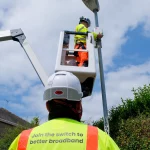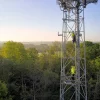H1 2022 – Gigabit Broadband Covers 99% of New Build UK Homes

The latest H1 2022 report into the broadband coverage of new build UK homes reveals that 99.03% of houses constructed during the first half of 2022 were connected to a gigabit-capable network (using full fibre FTTP and Hybrid Fibre Coax), which falls slightly to 98.03% when only looking at FTTP.
The data, which flows from Thinkbroadband‘s latest independent model (examination of new build postcodes), shows another improvement in the reach of Fibre-to-the-Premises technology, but we’d still recommend that those purchasing a new build home always get the property developer to confirm, in writing, what kind of service you can expect to receive before handing over any money.
Most large home builders (e.g. Home Builders Federation) have already entered into partnerships with operators (e.g. Openreach, Virgin Media, Hyperoptic and various altnet ISPs) to better facilitate the roll-out of full fibre broadband. Openreach have also made it even cheaper to deploy their FTTP network into some of the smallest developments (here). On top of that, new rules are coming to make all of this a requirement (here and here).
Advertisement
Despite this, some property developers still say that deploying full fibre services can, in some areas, be prohibitively expensive (e.g. remote rural locations), although this hasn’t always stopped many of those same companies from raking in big annual profits. Nevertheless, more and more new homes are arriving with full fibre availability as standard, and the impact of this is pretty clear.
New Build Broadband Cover by Speed and Technology (H1 2022 Data)
| New Premises | % Superfast 30Mbps+ | % Gigabit (FTTP + HFC) |
% Full Fibre (FTTP) | % Under 10Mbps USO |
| UK 2022 (71,156) | 99.8% | 99.03% | 98.03% | 0.1% |
| UK 2021 (168,846) | 99.2% | no data | 96.4% | 0.3% |
NOTE 1: The gigabit figure above reflects coverage by both FTTP and HFC DOCSIS (Cable) networks – mostly delivered via Openreach (BT) and Virgin Media. Meanwhile Hyperoptic, CommunityFibre, OFNL (GTC / BUUK), FibreNest and a few other altnets will also have an impact.
NOTE 2: Some small / individual developments (e.g. personal single house projects) or property conversions may be missed by this data.
NOTE 3: The historic figures may change as the related data is frequently being revised / updated, thus we’ve used the data from our last update for the 2021 figures.
NOTE 4: The availability of postcode data tends to lag deployments, which is why we only get a partial view of the current year in this update.
NOTE 5: A growing number of new build and existing sites constructed with fibre ducts from GTC (OFNL / BUUK) will also be able to carry Virgin Media’s (VMO2) services (here and here).
The full fibre gap has continued to shrink, and we suspect that, come the end of 2023, there may not be much point in continuing to track this progress as it will have reached a high level of maturity.
Mark is a professional technology writer, IT consultant and computer engineer from Dorset (England), he also founded ISPreview in 1999 and enjoys analysing the latest telecoms and broadband developments. Find me on X (Twitter), Mastodon, Facebook, BlueSky, Threads.net and Linkedin.
« South Western Railways Deploy 5G to Fuel Superfast Onboard WiFi





















































Comments are closed